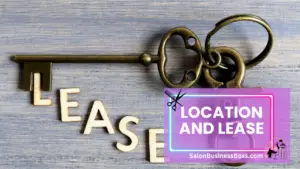Opening a beauty salon can be a rewarding venture, allowing entrepreneurs to tap into the ever-growing beauty industry. However, embarking on this journey requires careful financial planning.
Average cost to open a beauty salon is about $10,000 to $200,000. From location and lease to equipment, staff salaries, and marketing, budgeting carefully for these aspects ensures a successful and thriving salon business in the competitive beauty industry.
1. Location and Lease (Approx. 15% – 25% of Total Cost):

When venturing into the beauty salon business, choosing the perfect location is undeniably one of the most critical decisions to make. The significance of this choice lies in its potential to shape the salon’s success and profitability. The cost of the lease for the chosen location can significantly impact the overall budget of the salon startup.
Urban areas and prime locations, while attractive due to high foot traffic and visibility, often come with a price tag in the form of higher rents. On the other hand, suburban or rural settings may offer more affordable lease options but could lack the same level of exposure and potential clientele.
Allocating a reasonable portion of the total budget to secure a suitable location and sign a lease agreement is essential. Generally, experts advise setting aside around 15% to 25% of the overall budget for this purpose. Doing so ensures that the salon is strategically positioned to attract its target audience and generate a steady flow of customers.
The location’s accessibility, proximity to other businesses, parking availability, and the local demographic should all be carefully considered during the decision-making process. A well-chosen location not only enhances the salon’s visibility and client base but also contributes to the overall brand image and reputation. With thoughtful planning and financial prudence, the beauty salon owner can navigate this crucial aspect of the business successfully, setting the foundation for a thriving and profitable venture.
Read more about: Opening a Salon Business: Elevating Beauty Standards
2. Salon Infrastructure and Renovation (Approx. 20% – 30% of Total Cost):
Designing and crafting an appealing and meticulously planned salon environment plays a pivotal role in both drawing in and maintaining a loyal clientele. This encompasses a spectrum of expenditures, encompassing the rejuvenation of the physical space, incorporation of essential plumbing and electrical components, erection of partition walls to optimize functionality, selection of appropriate flooring options, strategic placement of illuminating light fixtures, and acquisition of comfortable and aesthetically pleasing furniture. The financial outlay for these endeavors can fluctuate substantially based on the extent of personalization and the intricacy of design components desired.
In the pursuit of crafting a salon that exudes a harmonious ambiance, earmarking a substantial portion of the total budget, generally ranging from 20% to 30%, is prudent for these purposes. This allocation acknowledges the significance of not just quality services but also the environment in which these services are rendered. A well-conceived and inviting salon setting can significantly enhance the overall customer experience, instilling a sense of relaxation and confidence. By thoughtfully investing in the salon’s physical attributes, business owners can position themselves to not only attract a steady stream of customers but also foster a lasting bond with them, nurturing the potential for sustained success in the competitive salon industry.
3. Equipment and Supplies (Approx. 25% – 35% of Total Cost):
Investing in premium salon equipment and supplies is a fundamental requisite for delivering exceptional services. This segment encompasses a spectrum of expenditures, spanning from sophisticated styling chairs and efficient hairdryers to luxurious washbasins, meticulous manicure and pedicure stations, advanced skincare machines, an array of hair products, and indispensable consumables. Allocating a substantial portion, typically ranging from 25% to 35%, of the overall budget to equipment and supplies is a prudent strategy to cultivate a salon that is not only aesthetically pleasing but also operationally efficient.
By prioritizing quality in these essentials, salons can elevate their service standards and provide clients with a seamless and indulgent experience. Clients are not merely seeking a haircut or treatment; they are seeking a holistic encounter that aligns with their expectations and desires. The investment in top-tier equipment echoes the salon’s commitment to excellence, instilling confidence in clients and fostering a loyal customer base.
Possessing well-maintained and up-to-date equipment can augment the efficiency of salon operations, reducing downtime and enhancing employee productivity. In an industry characterized by constant innovation, adapting to evolving trends and technologies is pivotal. By reserving a significant portion of the budget for equipment and supplies, salons can position themselves at the forefront of innovation, ensuring they remain competitive and capable of meeting evolving client demands. In sum, the allocation of resources towards superior salon equipment and supplies is an investment that reverberates through improved services, client satisfaction, and the long-term prosperity of the establishment.
4. Licensing and Permits (Approx. 5% – 10% of Total Cost):
Prior to embarking on the establishment of a beauty salon, it is imperative for entrepreneurs to undertake the acquisition of essential licenses and permits, ensuring strict adherence to local regulations. These prerequisites encompass a spectrum of legalities, encompassing licenses, health permits, zoning permits, and an array of other regulatory obligations. These expenditures, while potentially variable, typically amount to approximately 5% to 10% of the total budget.
Securing the necessary licenses and permits is not only a legal imperative but also a foundational step towards a successful and sustainable business endeavor. Compliance with local laws safeguards the salon against potential legal entanglements and interruptions to operations. Health permits are of particular significance within the beauty industry, signifying a commitment to maintaining high standards of hygiene and client well-being.
Zoning permits are equally pivotal, dictating the permissible usage of the physical space and ensuring alignment with local zoning ordinances. While these costs may seem relatively modest in comparison to other budgetary components, they wield substantial influence over the salon’s viability and credibility.
Neglecting or underestimating the significance of licenses and permits can have far-reaching ramifications, including fines, operational disruptions, and reputational damage. Investing the requisite resources in this facet of the salon’s establishment is a responsible course of action that not only engenders legal compliance but also underscores the entrepreneur’s dedication to operating a reputable and ethical business. In essence, the allocation of funds towards licenses and permits fortifies the foundation upon which the beauty salon’s success and longevity are constructed.
5. Marketing and Advertising (Approx. 10% – 15% of Total Cost):
Creating a prominent presence in the competitive beauty industry hinges on effective marketing and advertising endeavors. Devoting resources to these strategies, encompassing a diverse array of tactics such as website development, engaging social media campaigns, compelling print materials, and alluring promotions, is a pivotal investment. The allocation of approximately 10% to 15% of the total budget for marketing and advertising is a strategic move that can yield substantial returns.
In today’s digital age, a well-crafted website serves as a virtual storefront, offering potential clients insights into the salon’s services, ambiance, and expertise. Meanwhile, leveraging the power of social media facilitates direct engagement with the target audience, fostering a sense of community and relatability. Print materials such as brochures and business cards maintain a tangible presence, capturing attention in varied contexts.
Promotions and special offers can entice first-time clients and encourage repeat visits. These initiatives not only boost revenue but also nurture brand loyalty and word-of-mouth recommendations. The budget reserved for marketing and advertising acts as an investment in visibility, credibility, and brand resonance. Ultimately, these efforts converge to position the salon as a destination of choice among potential clients, translating into sustained growth and success.
6. Staff Salaries and Training (Approx. 20% – 30% of Total Cost):

The cornerstone of a thriving beauty salon rests on the shoulders of its personnel. The significance of skilled professionals cannot be overstated, and earmarking a substantial portion, around 20% to 30%, of the budget for staff salaries and training is a shrewd strategy.
Salon staff members are not just employees; they are the embodiment of the salon’s ethos and service quality. Adequate compensation acknowledges their expertise and commitment while fostering loyalty and reducing turnover rates. High-caliber professionals attract a discerning clientele seeking top-tier services, thereby driving revenue growth.
Investing in ongoing staff training is equally paramount. The beauty industry is dynamic, marked by ever-evolving techniques, trends, and technologies. Ensuring staff members are well-versed in the latest innovations enables the salon to offer cutting-edge treatments and cater to diverse client preferences. This fosters client trust, as they are assured of receiving the best possible service.
Allocating a significant budget for staff salaries and training underscores the salon’s dedication to excellence, attracting talent and nurturing a culture of continuous improvement. The resultant synergy between well-compensated, skilled professionals and satisfied clients creates a virtuous cycle, positioning the salon as a hub for exceptional beauty experiences and long-term success.
Read more about: Know Before You Go: Understanding Salon Set Up Cost
7. Contingency Fund (Approx. 5% – 10% of Total Cost):
In the nascent stages of a beauty salon’s operation, the unanticipated can swiftly become a reality. Unforeseen expenses and sudden emergencies are not uncommon, and it’s in these moments that having a well-fortified contingency fund assumes paramount importance. Setting aside approximately 5% to 10% of the total budget as a safety net is a strategic measure that ensures the salon’s stability and resilience in the face of the unforeseen.
A contingency fund serves as a financial cushion, ready to absorb unexpected blows that might otherwise disrupt the salon’s smooth operation. It acts as a safeguard against equipment breakdowns, unexpected repairs, sudden supply shortages, or other surprise costs that could jeopardize business continuity.
This reserve not only mitigates the financial impact of unforeseen events but also mitigates stress and anxiety for salon owners and management. Instead of scrambling for funds or resorting to drastic measures, the contingency fund provides a sense of security, allowing the salon to navigate challenges with a composed and strategic approach.
The fund signals prudence and foresight to stakeholders, including investors, clients, and employees. It showcases the salon’s commitment to long-term viability, responsible financial management, and the ability to weather uncertainties. By maintaining a contingency fund, the beauty salon demonstrates its dedication to providing consistent, uninterrupted services, solidifying its reputation as a dependable and resilient establishment in a competitive industry.
Conclusion
Opening a beauty salon can be a fulfilling entrepreneurial endeavor, but it requires a well-thought-out financial plan. The average cost to open a beauty salon can range from $10,000 to $200,000, depending on various factors. By carefully budgeting for expenses related to location and lease, salon infrastructure, equipment and supplies, licensing and permits, marketing, staff salaries, and a contingency fund, aspiring salon owners can increase their chances of building a successful and thriving business in the competitive beauty industry. Remember that these figures are approximate, and it’s essential to conduct thorough research and seek professional advice to create a budget tailored to your specific salon vision and goals.
Frequently Asked Questions

1. Can I open a beauty salon with a smaller budget?
Yes, starting with a smaller budget is possible, but it may limit the scale and scope of your salon. Careful planning and prioritizing expenses are essential.
2. How can I reduce costs without compromising on the quality of services?
Consider leasing a smaller space, exploring second-hand equipment options, and negotiating with suppliers for discounts to reduce costs.
3. Are there any hidden costs I should be aware of?
Yes, be prepared for unexpected expenses like utility deposits, building permits, and initial stock supplies that may add to your budget.
To learn more on how to start you own salon checkout my startup documents here.
Please note that the contents of this blog are for informational and entertainment purposes only and should not be construed as legal advice. Any action taken based on the information provided in this blog is solely at your own risk. Additionally, all images used in this blog are generated under the CC0 license of Creative Commons, which means they are free to use for any purpose without attribution.

About the author. Entrepreneur and Salon Business Fan.
Hi! I am Shawn and I am a happy individual who happens to be an entrepreneur. I have owned several types of businesses in my life from a coffee shop to an import and export business to an online review business plus a few more and now I create online salon business resources for those interested in starting new ventures. It’s demanding work but I love it. I do it for those passionate about their business and their goals. That’s why when I meet a salon business owner, I see myself. I know how hard the struggle is to retain clients, find good employees and keep the business growing all while trying to stay competitive.
That’s why I created Salon Business Boss: I want to help salon business owners like you build a thriving business that brings you endless joy and supports your ideal lifestyle.

